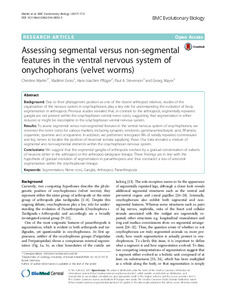Aufsatz
Artikel (Publikationen im Open Access gefördert durch die UB)

Assessing segmental versus non-segmental features in the ventral nervous system of onychophorans (velvet worms)
Abstract
Background:
Due to their phylogenetic position as one of the closest arthropod relatives, studies of the organisation of the nervous system in onychophorans play a key role for understanding the evolution of body segmentation in arthropods. Previous studies revealed that, in contrast to the arthropods, segmentally repeated ganglia are not present within the onychophoran ventral nerve cords, suggesting that segmentation is either reduced or might be incomplete in the onychophoran ventral nervous system.
Results:
To assess segmental versus non-segmental features in the ventral nervous system of onychophorans, we screened the nerve cords for various markers, including synapsin, serotonin, gamma-aminobutyric acid, RFamide, dopamine, tyramine and octopamine. In addition, we performed retrograde fills of serially repeated commissures and leg nerves to localise the position of neuronal somata supplying those. Our data revealed a mixture of segmental and non-segmental elements within the onychophoran nervous system.
Conclusions:
We suggest that the segmental ganglia of arthropods evolved by a gradual condensation of subsets of neurons either in the arthropod or the arthropod-tardigrade lineage. These findings are in line with the hypothesis of gradual evolution of segmentation in panarthropods and thus contradict a loss of ancestral segmentation within the onychophoran lineage.
Due to their phylogenetic position as one of the closest arthropod relatives, studies of the organisation of the nervous system in onychophorans play a key role for understanding the evolution of body segmentation in arthropods. Previous studies revealed that, in contrast to the arthropods, segmentally repeated ganglia are not present within the onychophoran ventral nerve cords, suggesting that segmentation is either reduced or might be incomplete in the onychophoran ventral nervous system.
Results:
To assess segmental versus non-segmental features in the ventral nervous system of onychophorans, we screened the nerve cords for various markers, including synapsin, serotonin, gamma-aminobutyric acid, RFamide, dopamine, tyramine and octopamine. In addition, we performed retrograde fills of serially repeated commissures and leg nerves to localise the position of neuronal somata supplying those. Our data revealed a mixture of segmental and non-segmental elements within the onychophoran nervous system.
Conclusions:
We suggest that the segmental ganglia of arthropods evolved by a gradual condensation of subsets of neurons either in the arthropod or the arthropod-tardigrade lineage. These findings are in line with the hypothesis of gradual evolution of segmentation in panarthropods and thus contradict a loss of ancestral segmentation within the onychophoran lineage.
Citation
In: BMC Evolutionary Biology. - London : BioMed Central. - (2017) 17:3Sponsorship
Gefördert durch den Publikationsfonds der Universität KasselCollections
Publikationen (Fachgebiet Zoologie)Artikel (Publikationen im Open Access gefördert durch die UB)
Citation
@article{urn:nbn:de:hebis:34-2017062652814,
author={Martin, Christine and Gross, Vladimir and Pflüger, Hans-Joachim and Stevenson, Paul A. and Mayer, Georg},
title={Assessing segmental versus non-segmental features in the ventral nervous system of onychophorans (velvet worms)},
year={2017}
}
0500 Oax 0501 Text $btxt$2rdacontent 0502 Computermedien $bc$2rdacarrier 1100 2017$n2017 1500 1/eng 2050 ##0##urn:nbn:de:hebis:34-2017062652814 3000 Martin, Christine 3010 Gross, Vladimir 3010 Pflüger, Hans-Joachim 3010 Stevenson, Paul A. 3010 Mayer, Georg 4000 Assessing segmental versus non-segmental features in the ventral nervous system of onychophorans (velvet worms) / Martin, Christine 4030 4060 Online-Ressource 4085 ##0##=u http://nbn-resolving.de/urn:nbn:de:hebis:34-2017062652814=x R 4204 \$dAufsatz 4170 7136 ##0##urn:nbn:de:hebis:34-2017062652814
<resource xsi:schemaLocation="http://datacite.org/schema/kernel-2.2 http://schema.datacite.org/meta/kernel-2.2/metadata.xsd"> 2017-06-26T13:24:04Z 2017-06-26T13:24:04Z 2017-01-03 1471-2148 urn:nbn:de:hebis:34-2017062652814 http://hdl.handle.net/123456789/2017062652814 Gefördert durch den Publikationsfonds der Universität Kassel eng Urheberrechtlich geschützt https://rightsstatements.org/page/InC/1.0/ Segmentation Nerve cord Ganglia Arthropod Panarthropoda 570 Assessing segmental versus non-segmental features in the ventral nervous system of onychophorans (velvet worms) Aufsatz Background: Due to their phylogenetic position as one of the closest arthropod relatives, studies of the organisation of the nervous system in onychophorans play a key role for understanding the evolution of body segmentation in arthropods. Previous studies revealed that, in contrast to the arthropods, segmentally repeated ganglia are not present within the onychophoran ventral nerve cords, suggesting that segmentation is either reduced or might be incomplete in the onychophoran ventral nervous system. Results: To assess segmental versus non-segmental features in the ventral nervous system of onychophorans, we screened the nerve cords for various markers, including synapsin, serotonin, gamma-aminobutyric acid, RFamide, dopamine, tyramine and octopamine. In addition, we performed retrograde fills of serially repeated commissures and leg nerves to localise the position of neuronal somata supplying those. Our data revealed a mixture of segmental and non-segmental elements within the onychophoran nervous system. Conclusions: We suggest that the segmental ganglia of arthropods evolved by a gradual condensation of subsets of neurons either in the arthropod or the arthropod-tardigrade lineage. These findings are in line with the hypothesis of gradual evolution of segmentation in panarthropods and thus contradict a loss of ancestral segmentation within the onychophoran lineage. open access In: BMC Evolutionary Biology. - London : BioMed Central. - (2017) 17:3 Martin, Christine Gross, Vladimir Pflüger, Hans-Joachim Stevenson, Paul A. Mayer, Georg doi:10.1186/s12862-016-0853-3 </resource>
The following license files are associated with this item:
Urheberrechtlich geschützt

